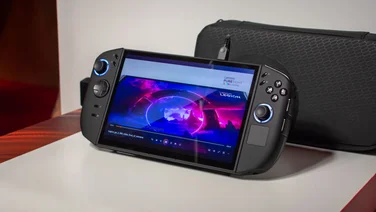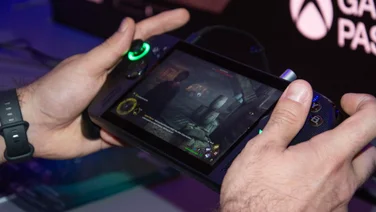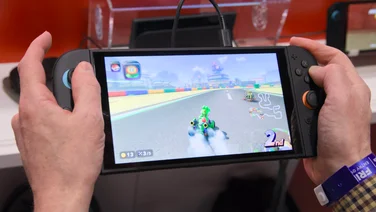To help us provide you with free impartial advice, we may earn a commission if you buy through links on our site. Learn more






- Clever clamp-on design
- Sensitive sticks and triggers
- Excellent ergonomics
- No haptic feedback
- Unnecessary and expensive add-on service
- Lacks key Xbox and DualSense buttons
Mobile gaming is big business and smartphone controllers like the Backbone One are becoming increasingly popular with gamers of all ages.
It seems we’re tired of being chained to our consoles and PCs; we want to game in the garden or while we’re on the move and devices like the Steam Deck, ROG Ally and Logitech G-Cloud are putting handheld gaming back in the spotlight. Sure, you don’t get the full 4K big-screen experience or the latest games in all their max settings glory, but convenience counts for a lot, especially if it means you can cram in the odd quick session when you wouldn’t otherwise get time.
However, you don’t necessarily need a new device to get a piece of the handheld gaming action. Pair a half-decent smartphone with the right controller, and you can game on something you already own. That’s the promise of a growing selection of smartphone gaming controllers, including the Razer Kishi v2, the GameSir X2 and X3, the Turtle Beach Atom and the Backbone One. The latter has expanded from the original iOS controller into a range covering iOS and Android smartphones and Xbox and PlayStation layouts. All give you a great handheld gaming experience, without the expense of splashing out on a Steam Deck or ROG Ally.
Backbone One review: What do you get for your money?
The Backbone One costs £100 and takes the form of a two-part controller connected by an expanding rear support. Each side clamps to one edge of your smartphone, transforming it into something close to a Nintendo Switch.

One half contains the controls you’d find on the left side of a standard games controller, along with capture and options buttons. The other side contains the right-hand stick, triggers and face buttons, along with a menu button, a dedicated Backbone button and a USB Type-C or Lightning port, depending on whether you choose the iOS or Android variety. The matching connector sits semi-concealed inside the clamping section, on the right-hand side.
Following Apple’s announcement that its next-generation iPhones will use USB-C, the USB-C versions of the Backbone One are also now being upgraded to support iOS. If you plan to play Resident Evil 4 Remake or Assassin’s Creed: Mirage on your iPhone 15, this is the controller you’re going to want to do it with.
Backbone One review: How does it work?
Extend the rear support as far as it will go, slot your phone into place over the connector, and then gently release the left-hand half. As long as you’ve got it positioned correctly, the phone locks into place. Once that happens, the whole shebang feels surprisingly sturdy. As long as you don’t twist the Backbone One too much, it’s about as close to a dedicated handheld as an ordinary smartphone’s going to get. I tested the iPhone PlayStation version with an ageing iPhone XR, and it’s a really good, snug fit, working even better than the Samsung Galaxy S20 FE and Android Razer Kishi V2 combo I regularly use.Ergonomically, the Backbone One works pretty well. There’s always a balance to be found between keeping the controller slim and light and giving you enough controller to grip onto, but each half of the Backbone One is just chunky enough to give you a decent grip. In fact, ergonomically, it’s a little better than the less rounded and grabable Kishi V2 – itself an excellent controller.
Once it’s all hooked up, you’re good to go with any game or app that supports a game controller, including streaming services such as GeForce Now, Amazon Luna and Xbox Games Pass Ultimate, local streaming apps such as Steam Link and PS5 Remote Play, or many iOS or Android games.
Backbone One review: How good are the controls?
With a few caveats, very convincing. The sticks are a lot smaller than the thumbsticks on the DualSense or Xbox Wireless controllers – or even the sticks on the Switch joycons – but they feel solid, accurate and sensitive enough for FPS and racing games. It might take a while before you’re aiming with the accuracy and finesse you might have on a console controller, but there are no vast dead zones to contend with, and I haven’t had any issues with navigating turns in Forza Horizon 5 or Need for Speed: Unleashed, or managing angled jumps in action games – all areas where poor controls can cause trouble.
Backbone has been smart with the triggers, too, turning the L1 and R1 bumpers into slimmer triggers you can still find and squeeze with ease, and the L2 and R2 triggers into larger analogue efforts with enough resistance to give you a degree of fine control. While I missed the DualSense controller’s haptic triggers while streaming PS5 games, the general feel and playability aren’t bad at all. It also helps that the face buttons feel a little larger and tighter than those on the Razer Kishi V2, while the cross-shaped D-Pad also works well.

The real test for me is whether I can forget I’m playing on a smartphone with a controller clamped on and just get absorbed in a game. Whether streaming games from Xbox Games Pass Ultimate or GeForce Now or locally from my PS5, the Backbone One managed this at least 90% of the time. And when it didn’t, it was often more to do with the reduced screen size or legibility of text than anything to do with the controls. Playing Starfield on a smartphone is a hoot until you realise that it’s nigh-on impossible to read some elements of the UI. Ditto for Diablo 4.
It’s also a treat to be able to play Android games with a proper controller rather than touch controls. Genshin Impact and Call of Duty: Mobile are significantly more playable, while Diablo Immortal is a lot closer in feel to the console Diablo games.
READ NEXT: The best TVs for gaming
Backbone One review: Are there any extra features?
Backbone has its own Backbone App to cover firmware updates and calibration, and this also includes a free trial of Backbone+. This is a subscription service that brings all your games across multiple apps and services within the Backbone App, but it comes with a steep annual cost of £39 and feels far from essential – or even desirable. In fact, it sometimes feels like it’s getting in the way, while adding an extra orange Backbone button to the controller that could be better used elsewhere.

On the plus side, the controller has a headphones socket in the left-hand grip, perfect for plugging in your favourite gaming headset.
READ NEXT: Our favourite Xbox Series X controllers
Backbone One review: What could be improved?
As you might have noticed, the Backbone One doesn’t mirror every button on a console controller. There’s no Xbox button or equivalent, and also no PlayStation button or any replacement for the central touchpad. That’s a bit of a menace when you want to drop out of a game or shut down your console, or when you need the touchpad to access an in-game inventory or map. Instead, you have to fall back on the relevant app’s touch controls. See what I mean about the orange Backbone button?

It’s also a bit cheeky for the Backbone App to have a button remapping function which only tells you to see the general controller settings within iOS, especially when this doesn’t allow you to remap the function or capture buttons to cover the missing Xbox or DualSense controls.
Backbone One review: Should you buy it?
A lot depends on the phone you’re going to partner your Backbone One with. Pick a smartphone with a big screen, good connectivity and some decent processing power for running local games, and you have a very workable gaming handheld without spending more than £100. The price puts it right up against the Razer Kishi v2, but the Backbone One has superior face buttons, triggers and analogue sticks, not to mention slightly stronger ergonomics overall.
Of course, paying big bucks for a Steam Deck, Asus ROG Ally or streaming handheld will give you a better experience, along with a bigger screen and less reliance on an internet connection. Yet it’s also a more serious investment. If you’d rather use what you already have for gaming, the Backbone One is the best tool for the job.








